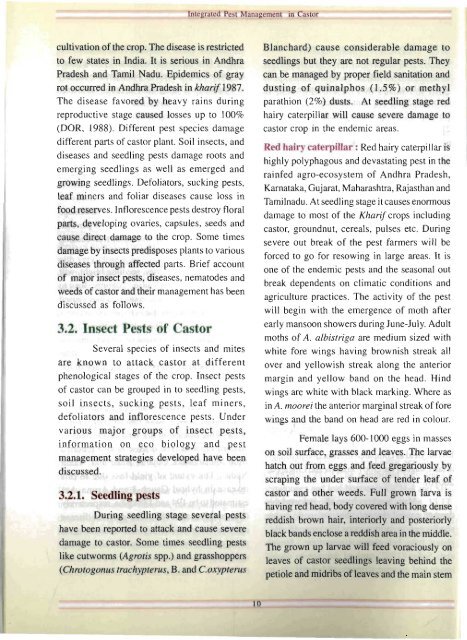Directorate of Oilseeds Research
Directorate of Oilseeds Research
Directorate of Oilseeds Research
You also want an ePaper? Increase the reach of your titles
YUMPU automatically turns print PDFs into web optimized ePapers that Google loves.
Integrated Pest Management in Castor<br />
cultivation <strong>of</strong> the crop. The disease is restricted<br />
to few states in India. It is serious in Andhra<br />
Pradesh and Tamil Nadu. Epidemics <strong>of</strong> gray<br />
rot occurred in Andhra Pradesh in kharif 1987.<br />
The disease fa\(ored by heavy rains during<br />
reproductive stage caused losses up to 100%<br />
(DOR, 1988). Different pest species damage<br />
different parts <strong>of</strong> castor plant. Soil insects, and<br />
diseases and seedling pests damage roots and<br />
emeroino<br />
t::> t::><br />
seedlings as well as emerged and<br />
growing seedlings. Defoliators, sucking pests,<br />
leaf miners and foliar diseases cause loss in<br />
food reserves. Inflorescence pests destroy floral<br />
parts, developing ovaries, capsules, seeds and<br />
cause direct damage to the crop. Some times<br />
damage by insects predisposes plants to various<br />
diseases through affected parts. Brief account<br />
<strong>of</strong> major insect pests, diseases, nematodes and<br />
weeds <strong>of</strong> castor and their management has been<br />
discussed as follows.<br />
3.2. Insect Pests <strong>of</strong> Castor<br />
Several species <strong>of</strong> insects and mites<br />
are known to attack castor at different<br />
phenological stages <strong>of</strong> the crop. Insect pests<br />
<strong>of</strong> castor can be grouped in to seedling pests,<br />
soi l insects, sucking pests, leaf miners,<br />
defoliators and inflorescence pests. Under<br />
various major groups <strong>of</strong> insect pests,<br />
information on eco biology and pest<br />
management strategies developed have been<br />
discussed.<br />
3.2.1. Seedling pests<br />
During seedling stage several pests<br />
have been reported to attack and cause severe<br />
damage to castor. Some time seedling pests<br />
like cutworms (Agrotis spp.) and grasshoppers<br />
(Chrotogonus trachypterus, B. and c.oxypterus<br />
Blanchard) cause considerable damage to<br />
seedlings but they are not regular pests. They<br />
can be managed by proper field sanitation and<br />
dusting <strong>of</strong> quinalphos (1.5%) or methyl<br />
parathion (2%) dusts. At seedling stage red<br />
hairy caterpillar will cause severe damage to<br />
castor crop in the endemic areas.<br />
Red hairy caterpillar: Red hairy caterpillar is<br />
highly polyphagous and devastating pest in the<br />
rainfed agro-ecosystem <strong>of</strong> Andhra Pradesh,<br />
Karnataka, Gujarat, Maharashtra, Rajasthan and<br />
Tamilnadu. At seedling stage it causes enormous<br />
damage to most <strong>of</strong> the Kharif crops including<br />
castor, groundnut, cereals, pulses etc. During<br />
severe out break <strong>of</strong> the pest farmers will be<br />
forced to go for resowing in large areas. It is<br />
one <strong>of</strong> the endemic pests and the seasonal out<br />
break dependents on climatic conditions and<br />
agriculture practices. The activity <strong>of</strong> the pest<br />
will begin with the emergence <strong>of</strong> moth after<br />
early mansoon showers during June-July. Adult<br />
moths <strong>of</strong> A. albistriga are medium sized with<br />
white fore wings having brownish streak all<br />
over and yellowish streak along the anterior<br />
margin and yellow band on the head. Hind<br />
winos are white with black marking. Where as<br />
/::)<br />
in A. moorei the anterior marginal streak <strong>of</strong> fore<br />
wings and the band on head are red in colour.<br />
Female lays 600-1000 eggs in masses<br />
on soi l surface, grasses and leaves. The larvae<br />
hatch out from eggs and feed gregariously by<br />
scraping the under surface <strong>of</strong> tender leaf <strong>of</strong><br />
castor and other weeds. Full grown larva is<br />
having red head, body covered with long dense<br />
reddish brown hair, interiorly and posteriorly<br />
black bands enclose a reddish area in the middle.<br />
The grown up larvae will feed voraciously on<br />
leaves <strong>of</strong> castor seedlings leaving behind the<br />
petiole and midribs <strong>of</strong> leaves and the main stem<br />
10
















